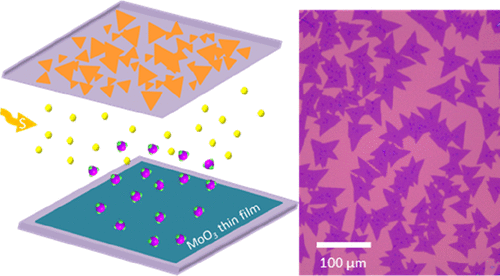Our official English website, www.x-mol.net, welcomes your
feedback! (Note: you will need to create a separate account there.)
Uniform Vapor-Pressure-Based Chemical Vapor Deposition Growth of MoS2 Using MoO3 Thin Film as a Precursor for Coevaporation
ACS Omega ( IF 3.7 ) Pub Date : 2018-12-31 00:00:00 , DOI: 10.1021/acsomega.8b02978 Sajeevi S. Withanage 1, 2 , Hirokjyoti Kalita 2, 3 , Hee-Suk Chung 4 , Tania Roy 2, 3, 5 , Yeonwoong Jung 2, 3, 5 , Saiful I. Khondaker 1, 2, 3
ACS Omega ( IF 3.7 ) Pub Date : 2018-12-31 00:00:00 , DOI: 10.1021/acsomega.8b02978 Sajeevi S. Withanage 1, 2 , Hirokjyoti Kalita 2, 3 , Hee-Suk Chung 4 , Tania Roy 2, 3, 5 , Yeonwoong Jung 2, 3, 5 , Saiful I. Khondaker 1, 2, 3
Affiliation

|
Chemical vapor deposition (CVD) is a powerful method employed for high-quality monolayer crystal growth of 2D transition metal dichalcogenides with much effort invested toward improving the growth process. Here, we report a novel method for CVD-based growth of monolayer molybdenum disulfide (MoS2) by using thermally evaporated thin films of molybdenum trioxide (MoO3) as the molybdenum (Mo) source for coevaporation. Uniform evaporation rate of MoO3 thin films provides uniform Mo vapors which promote highly reproducible single-crystal growth of MoS2 throughout the substrate. These high-quality crystals are as large as 95 μm and are characterized by scanning electron microscopy, Raman spectroscopy, photoluminescence spectroscopy, atomic force microscopy, and transmission electron microscopy. The bottom-gated field-effect transistors fabricated using the as-grown single crystals show n-type transistor behavior with a good on/off ratio of 106 under ambient conditions. Our results presented here address the precursor vapor control during the CVD process and is a major step forward toward reproducible growth of MoS2 for future semiconductor device applications.
中文翻译:

使用MoO 3薄膜作为共蒸发的前驱物,基于MoS 2的均匀基于压力的化学气相沉积生长
化学气相沉积(CVD)是用于2D过渡金属二卤化金属的高质量单层晶体生长的有效方法,并投入大量精力来改善生长过程。在这里,我们报告了一种新的方法,该方法通过使用热蒸发的三氧化钼(MoO 3)薄膜作为共蒸发的钼(Mo)源,对基于化学气相沉积的单层二硫化钼(MoS 2)进行生长。MoO 3薄膜的均匀蒸发速率提供均匀的Mo蒸气,从而促进MoS 2的高度可再现的单晶生长遍及整个基材。这些高质量的晶体大至95μm,并具有扫描电子显微镜,拉曼光谱,光致发光光谱,原子力显微镜和透射电子显微镜的特征。使用生长中的单晶制造的底栅场效应晶体管在环境条件下显示出具有良好的开/关比10 6的n型晶体管性能。本文介绍的结果解决了CVD工艺中的前驱物蒸气控制问题,是朝着可再生的MoS 2增长迈出的重要一步,可用于未来的半导体器件应用。
更新日期:2018-12-31
中文翻译:

使用MoO 3薄膜作为共蒸发的前驱物,基于MoS 2的均匀基于压力的化学气相沉积生长
化学气相沉积(CVD)是用于2D过渡金属二卤化金属的高质量单层晶体生长的有效方法,并投入大量精力来改善生长过程。在这里,我们报告了一种新的方法,该方法通过使用热蒸发的三氧化钼(MoO 3)薄膜作为共蒸发的钼(Mo)源,对基于化学气相沉积的单层二硫化钼(MoS 2)进行生长。MoO 3薄膜的均匀蒸发速率提供均匀的Mo蒸气,从而促进MoS 2的高度可再现的单晶生长遍及整个基材。这些高质量的晶体大至95μm,并具有扫描电子显微镜,拉曼光谱,光致发光光谱,原子力显微镜和透射电子显微镜的特征。使用生长中的单晶制造的底栅场效应晶体管在环境条件下显示出具有良好的开/关比10 6的n型晶体管性能。本文介绍的结果解决了CVD工艺中的前驱物蒸气控制问题,是朝着可再生的MoS 2增长迈出的重要一步,可用于未来的半导体器件应用。

































 京公网安备 11010802027423号
京公网安备 11010802027423号